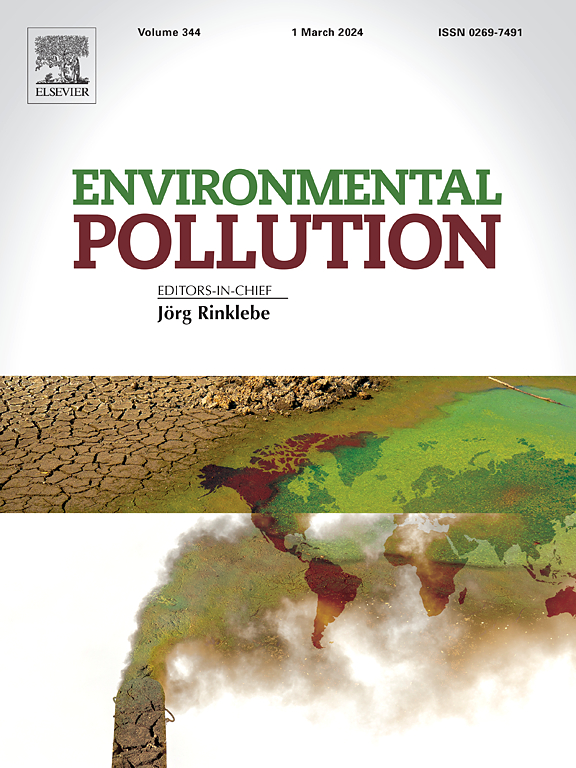宏基因组分析揭示了蚯蚓种类对畜禽粪便中抗生素抗性组的显著影响
IF 7.6
2区 环境科学与生态学
Q1 ENVIRONMENTAL SCIENCES
引用次数: 0
摘要
动物源性抗生素耐药基因(ARGs)已成为一种严重威胁,而蠕虫堆肥已被认为是减少ARGs的有效策略。然而,不同种类的蚯蚓在减少ARGs方面的功效仍然知之甚少。本研究收集了来自不同蚯蚓养殖场的72份蚯蚓堆肥和蚯蚓肠道样本,通过宏基因组分析评估了不同蚯蚓种类的蚯蚓堆肥对ARGs的影响。在肠道和蠕虫堆肥样本中检测到大约28种ARG类型。4种蚯蚓堆肥系统的ARGs存在显著差异(p <;0.05),每个物种都有其优势的ARGs和微生物。变形菌门(46.89%)和肥肠爱森菌门(48.42%)为主要菌门,而古Euryarchaeota(36.71%)和euudrilus eugenae(39.42%)分别为最丰富的菌门。粪Eisenia fetida处理的蚯蚓堆肥中ARGs的总体丰度(0.18拷贝/16S rRNA基因拷贝数)低于其他蚯蚓物种(0.23-0.39拷贝/16S rRNA基因拷贝数),肠道微生物被认为是ARG减少变化的关键决定因素。这些发现为选择合适的蚯蚓物种促进ARG降解提供了有价值的见解,从而有助于降低ARG在农业生态系统中的传播风险。本文章由计算机程序翻译,如有差异,请以英文原文为准。


Significant effects of earthworm species on antibiotic resistome in livestock manure as revealed by metagenomic analysis
Animal-derived antibiotic resistance genes (ARGs) have emerged as a critical threat, while vermicomposting has been recognized as an effective strategy for reducing ARGs. However, the efficacy of different earthworm species in reducing ARGs remains poorly understood. In this study, 72 vermicompost and earthworm gut samples were collected from various earthworm farms to evaluate the impact of vermicomposting with different earthworm species on ARGs via metagenomic analysis. Approximately 28 ARG types were detected in gut and vermicompost samples. There were significant differences in ARGs among the four species of earthworm composting systems (p < 0.05), and each species possessed its dominant ARGs and microbes. Proteobacteria represented the predominant bacterial phylum within the gut microbiota of Pheretima guillelmi (46.89 %) and Eisenia fetida (48.42 %), whereas Euryarchaeota (36.71 %) and Actinobacteria (39.42 %) were the most abundant in Perionyx excavatus and Eudrilus eugeniae, respectively. The overall abundance of ARGs in vermicompost processed by Eisenia fetida (0.18 copies16S rRNA gene copies) was lower than that observed in other earthworm species (0.23–0.39 copies/16S rRNA gene copies), with gut microbial identified as a key determinant of variations in ARG reduction. These findings provide valuable insights into selecting suitable earthworm species to promote ARG degradation, thus contributing to the decrease in ARG dissemination risks in agricultural ecosystems.
求助全文
通过发布文献求助,成功后即可免费获取论文全文。
去求助
来源期刊

Environmental Pollution
环境科学-环境科学
CiteScore
16.00
自引率
6.70%
发文量
2082
审稿时长
2.9 months
期刊介绍:
Environmental Pollution is an international peer-reviewed journal that publishes high-quality research papers and review articles covering all aspects of environmental pollution and its impacts on ecosystems and human health.
Subject areas include, but are not limited to:
• Sources and occurrences of pollutants that are clearly defined and measured in environmental compartments, food and food-related items, and human bodies;
• Interlinks between contaminant exposure and biological, ecological, and human health effects, including those of climate change;
• Contaminants of emerging concerns (including but not limited to antibiotic resistant microorganisms or genes, microplastics/nanoplastics, electronic wastes, light, and noise) and/or their biological, ecological, or human health effects;
• Laboratory and field studies on the remediation/mitigation of environmental pollution via new techniques and with clear links to biological, ecological, or human health effects;
• Modeling of pollution processes, patterns, or trends that is of clear environmental and/or human health interest;
• New techniques that measure and examine environmental occurrences, transport, behavior, and effects of pollutants within the environment or the laboratory, provided that they can be clearly used to address problems within regional or global environmental compartments.
 求助内容:
求助内容: 应助结果提醒方式:
应助结果提醒方式:


